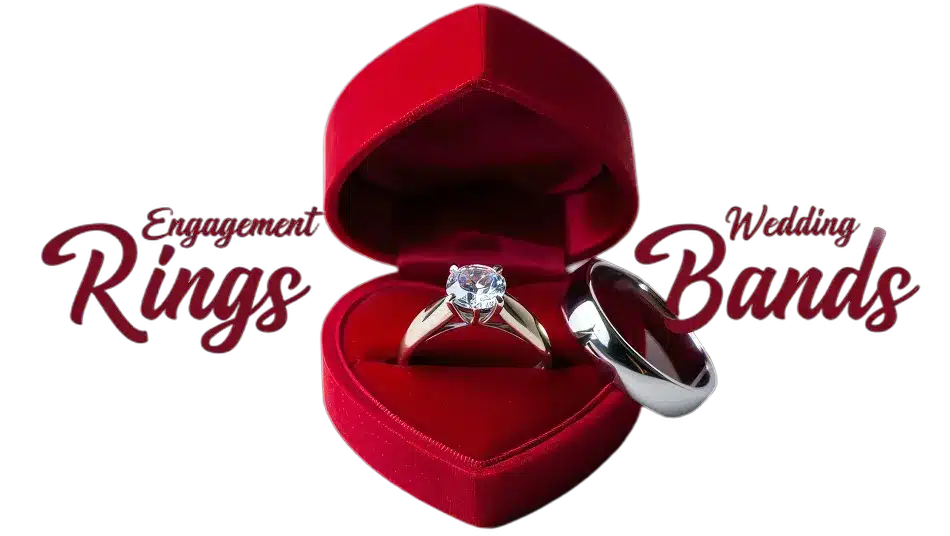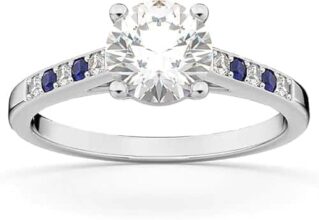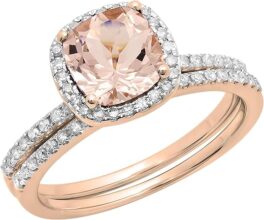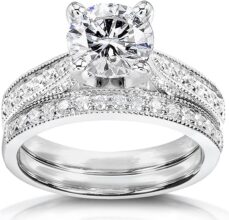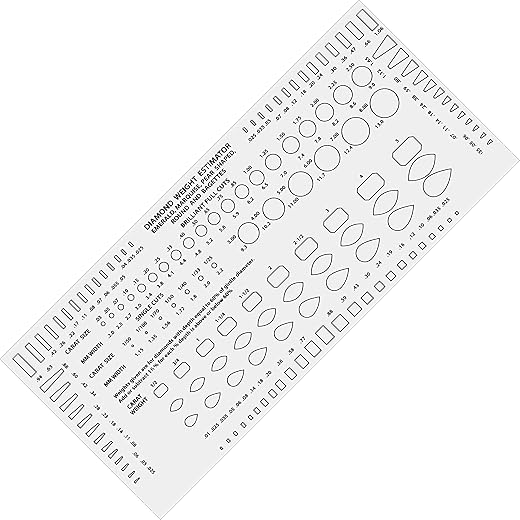
Welcome to Your Engagement Ring Journey
Embarking on the journey to choose the perfect engagement ring is an exciting experience. One of the key factors you’ll encounter along the way is carat weight. But what does that really mean for you?
Understanding carat weight is essential as it influences not just the size of the stone but also its price and overall appeal. This seemingly simple metric can actually have a profound impact on your choices—and we’re here to guide you through it.
From balancing size and quality to considering your personal preferences and lifestyle, this article aims to arm you with the knowledge you need. Let’s dive into the world of carat weight and discover how it can help you create the engagement ring of your dreams!




What is Carat Weight?
When you hear the term carat weight, you might think it’s merely a measure of size, but it’s so much more than that. The carat is a unit of weight that specifically measures gemstones, and in the case of diamonds, one carat equals 0.2 grams (or 200 milligrams). So, a one-carat diamond weighs 200 milligrams, but it’s important to remember that it doesn’t directly translate to how big the diamond appears.
Understanding Carat Weight
Carat weight impacts more than just the dimensions of the diamond; it also plays a significant role in its overall value. As the weight increases, so does the price—often exponentially. If you’re envisioning a larger stone, you might be surprised to see how a slight increase in carat weight can make a noticeable difference in cost. For example:
Carat vs. Other Diamond Qualities
It’s vital to distinguish carat weight from other aspects of a diamond’s quality, such as cut and clarity. While carat describes how much a diamond weighs, the cut refers to how well the diamond has been shaped and faceted, affecting its sparkle and brilliance. Clarity, on the other hand, measures the presence of any internal flaws or inclusions.
When you shop for rings, you’ll want to appreciate how these factors interplay. A well-cut diamond can appear larger than its actual carat weight, while a poorly cut diamond can look smaller despite having the same weight. Knowing this allows you to prioritize your preferences better.
The Bottom Line
In your engagement ring journey, understanding carat weight is just the first step. As you explore your options, consider how carat interacts with the other critical elements of a diamond’s beauty and overall appearance. Keep in mind your personal style and budget when weighing your choices.
Next, let’s explore how carat weight influences price, and discover how to get the best bang for your buck when it comes to your dream engagement ring!
How Carat Weight Influences Price
When it comes to purchasing an engagement ring, the weight of the diamond plays a significant role in its pricing structure. As you navigate the options available, understanding the intricate relationship between carat weight and price will empower you in making informed decisions.
The Exponential Price Increase
Larger diamonds not only weigh more but also cost significantly more due to their rarity. The relationship between carat weight and price can often be described as exponential. For example:
One way to illustrate this leap in cost is with a common comparison: imagine two diamonds that are almost similar in appearance. The first diamond is just shy of one carat at 0.95 carats, and the second is a full 1.00 carat. The difference in weight can translate to several hundred, if not thousands, of dollars! Isn’t that fascinating?
Understanding Rarity and Demand
Larger gemstones are rarer because natural diamonds become increasingly difficult to find as they grow in size. Consequently, diamonds that reach the one-carat mark—and particularly those above—tend to be sought after, affecting their price tag. Here are a few key points to keep in mind regarding rarity:
Balancing Size and Budget
As you consider your options, remember that choosing a ring isn’t merely about size. Many couples find a sweet spot in the carat weight that fits both their budget and their vision. For example, a 0.90-carat diamond can deliver a similar visual impact to a 1.00-carat but typically comes with a much lower price tag, allowing you to allocate the remaining budget towards other qualities like cut, color, or even a more luxurious setting.
Engagement rings are deeply personal, and being informed about how carat weight impacts price allows you to explore exciting variations while staying true to your budget.
In the next section, we’ll take a closer look at how to find the right balance between size and quality, ensuring that your engagement ring reflects not just a carat weight but your unique love story!
Finding the Right Balance: Size vs. Quality
As you dive deeper into the world of engagement rings, understanding the delicate dance between carat weight and the other crucial factors—like cut and clarity—becomes paramount. Each element plays a distinct role in the overall beauty and value of your ring. Ultimately, finding the right balance will help you create a stunning piece that fits both your vision and your budget.
The Cut as a Key Player
Let’s start with the cut. A well-cut diamond can capture and reflect light in a way that makes it dazzle far beyond its carat weight. The brilliance and fire often steal the show, meaning a smaller diamond with an exceptional cut can appear more extravagant than a larger, poorly cut stone. For example, if you’re torn between a 1.00-carat diamond with a mediocre cut and a 0.80-carat diamond with an excellent cut, the latter could be the more stunning choice.
Clarity: The Invisible Factors
Next up is clarity. This measures the presence of any internal inclusions or surface blemishes. Higher clarity ratings not only contribute to the stone’s value but also its aesthetic appeal. While you might want to opt for a larger, lower-clarity stone, it’s essential to consider how visible those imperfections will be. Think of it this way: a 1.50-carat diamond might have inclusions that are eye-visible, while a 1.00-carat diamond with flawless clarity could be truly breathtaking.
Budgeting Wisely
You may feel pressure to choose the largest diamond possible, but remember, your budget can guide these decisions. Efficiently distributing funds between carat weight and quality aspects can lead to a ring that feels substantial but doesn’t require a hefty investment. For instance, if an extra half carat pushes the price into a higher bracket, using those funds instead for a genuinely beautiful cut and high clarity can lead to a more captivating ring.
Real-Life Example
Picture this: friends of yours recently got engaged—she chose a 0.85-carat round diamond with an exceptional cut and clarity rating. The ring sparkled beautifully, drawing compliments from everyone. They felt they received incredible value because the ring looked larger and more radiant than a 1.00 or even 1.25-carat diamond with lesser quality. Their choice emphasized quality over mere size, ensuring her ring was unique and impressive.
Your Unique Style
Ultimately, the best engagement ring reflects not just the carat weight but your personal tastes and lifestyle. Prioritize what means the most to you. Do you favor a classic solitaire, or do you envision a vintage halo setting? Addressing these design preferences will also influence the balance between size and quality, so think carefully about what fits your partner’s style.
As you ponder these elements, get ready to think about how personal preferences and lifestyle considerations shape your overall vision for the engagement ring. In the next section, we’ll explore how these factors come into play, ensuring that the chosen ring isn’t just beautiful, but also a true reflection of your love story.
The Visual Impact of Carat Weight
When it comes to the appearance of your diamond, carat weight plays a vital role, but it doesn’t tell the whole story. You might imagine a larger diamond automatically translating to more sparkles and “wow” factor, but various factors—including shape and setting—greatly influence how your diamond appears to the eye.
Shape Matters
Different diamond shapes can alter perceived size significantly. For instance, a round brilliant cut is renowned for its brilliance, but it may appear smaller than a princess cut of the same carat weight. Here’s a quick comparison:
Choosing a shape that features broader facets or a more extensive surface area, such as an oval or marquise, can enhance perceived size, making your diamond look larger while staying within a budget-friendly carat weight.
The Influence of the Setting
The right setting can also affect how large a diamond appears. Different styles can create an illusion of size by using visual tricks. Consider these popular settings:
With the [3.75 Carat Round Lab Grown Diamond Ring], for example, the halo design amplifies the central stone’s size, allowing the beauty of the diamond to shine even more brightly. Alternatively, a simple solitaire setting may emphasize the stone’s individual beauty without relying on embellishments.
Color and Clarity Perception
Believe it or not, the diamond’s color and clarity can also change how we perceive its size. A stone with a higher clarity grade allows more light to pass through, enhancing its brilliance, which can make it seem larger. Meanwhile, a diamond that’s slightly tinted in color could be perceived as smaller since the color could detract from its overall radiance.
Real-World Magic
Imagine attending a friend’s wedding where the bride chose a 1.5-carat diamond in a delicate halo setting. Its brilliance sparked envy, as it seemed to pick up every ounce of light, dazzling every guest. In contrast, at another event, you might notice a 2.0-carat diamond that didn’t quite have the same impact, as it was set in a heavier, more cumbersome band, overshadowing its sparkle.
Make Design Choices Mindfully
As you navigate your engagement ring journey, consider how these factors play together to create a customized look that suits you or your partner. Choose a diamond shape and setting that enhances perceived size without overstretching your budget.
As you embrace the visual dynamics of carat weight, prepare to reflect on your personal preferences and lifestyle considerations in our next section. Together, these elements will ensure your engagement ring resonates beautifully with your story and style!
Your Personal Preferences and Lifestyle Considerations
When it comes to selecting the perfect engagement ring, your personal style and lifestyle should take center stage. After all, this is a piece you’ll wear every day, so it must resonate with who you are and what you do. As you contemplate the carat weight of your diamond, consider how practical aspects influence aesthetics and symbolism.
Reflecting Your Personal Style
Before diving into practicalities, think about your style. Do you gravitate toward classic elegance, or are you drawn to more modern, unique designs? Understanding your aesthetic will help guide your choice of carat weight. Here are a few questions to consider:
Practical Lifestyle Considerations
Now, let’s get down to practicality. Your lifestyle should heavily influence your choice of carat weight and the type of engagement ring you choose. For instance, if you lead an active life, you might favor a smaller carat weight that’s more durable and less prone to snagging.
Furthermore, consider how easy the ring is to care for. For instance, intricate settings may require more frequent cleaning to remove dirt and grime, while simpler designs can maintain their brilliance with less effort.
Balancing Sentimental Value and Visibility
The emotional significance of the ring plays a massive role in your decision-making. A higher carat weight may look impressive, but it’s essential that it also embodies your love story. You might appreciate a smaller, more meaningful diamond that reflects a pivotal moment in your relationship, rather than purely opting for size.
Lastly, don’t underestimate the power of personal touch. Some couples choose to incorporate family stones or heirloom pieces into their ring—a creative way to celebrate legacy while emphasizing uniqueness.
As you reflect on what feels right for you, remember that your engagement ring is more than a symbol of love; it’s an enduring representation of your shared journey. Ready to take the next step? Let’s dive into our conclusion to bring all these insights together, ensuring that your final choice is loving, intentional, and perfectly you.
Making Informed Choices for Your Engagement Ring
As you embark on your engagement ring journey, understanding carat weight is essential. It’s more than just a number—it impacts the ring’s price, visual appeal, and ultimately, your satisfaction. By weighing carat size against quality, personal style, and lifestyle, you can discover a ring that not only captivates but also aligns with your unique preferences.
Remember, the perfect engagement ring is a reflection of your love story. Take the time to explore each aspect of carat weight and how it fits into your vision. Embrace the journey, and soon you’ll find a ring that you will cherish for a lifetime. Happy ring shopping!
